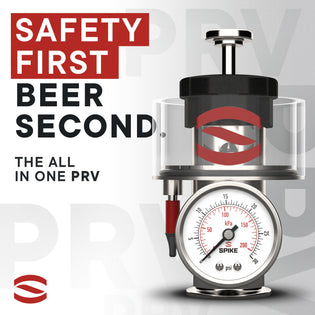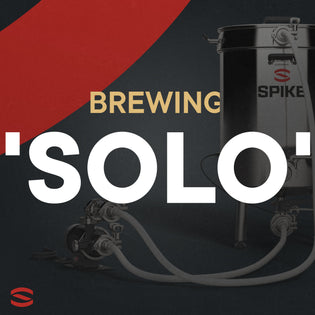By Ethan Keller
My name is Ethan Keller, owner and cidermaker at Cache Cider in Milwaukee, WI. Today we’ll chat about a winemaker’s approach to producing small batch, low intervention hard cider.

I made my first hard cider in 2011, and enrolled in wine school starting in 2019. I’m a musician by trade, but built the city’s first licensed winemaking facility during the 2020 pandemic.
There are still a lot of misconceptions about hard cider. Let’s answer some frequently asked questions people have about small batch cider making, so let’s start with the basics…
What is Cider?
Cider is an alcoholic beverage that is typically made from fermented apple juice. It has a long history and is enjoyed in various forms in different parts of the world. The production process involves crushing apples to extract the juice, which is then fermented using yeast. This fermentation process converts the sugars in the juice into alcohol, resulting in a flavorful and slightly carbonated beverage.

Ciders can range in taste and sweetness depending on the type of apples used and the fermentation process. Some ciders are dry and crisp, while others may be sweeter and more fruity. They can also vary in color, ranging from pale yellow to deep amber.
What is Hard Cider?
Hard cider refers to a specific type of cider that contains alcohol. It is made through the fermentation of apple juice, just like traditional cider, but with the addition of yeast to convert the sugars in the juice into alcohol. The fermentation process can take anywhere from a few weeks to several months, depending on the desired flavor profile.
Hard cider typically has an alcohol content ranging from 4% to 8% ABV (alcohol by volume), although some ciders can have higher alcohol content. The taste and characteristics of hard cider can vary widely depending on factors such as the variety of apples used, the fermentation process, and any additional ingredients or flavors added during production.
In recent years, hard cider has gained popularity as a refreshing alternative to beer and wine. It is available in various styles, ranging from dry and crisp to sweet and fruity. Some ciders may also be infused with additional flavors, such as berries, spices, or hops, to create unique taste profiles.
Are there Different Types of Cider?
There are many kinds of ciders. Sweet. Dry. Carbonated. Still. Germany has apfelwein. Spain has cidre. French cider regulations determine how cider in Normandy is made. Countries like the US and Australia have strong cider traditions like European countries do.

What’s the Difference between Apple Cider and Hard Apple Cider?
“Apple cider” is non-alcoholic apple cider. “Hard cider” is apple cider that has been fermented, and contains alcohol.
Is there a Taste Difference between Regular Cider and Hard Cider?
The taste difference between apple cider and hard cider will vary depending on the cider-making technique. Generally, hard cider is less sweet than apple cider, as the yeast has metabolized many to all of the sugars in the beverage.
What are the Top Qualities to Look for in a Cider?
People’s tastes are different and that should be celebrated. Some individuals love dry ciders, some people prefer sweeter ones. Some like more acidity, some people don’t. Some like more astringency, some do not enjoy much mouthfeel. Some enjoy funkiness, complexity, and aftertaste, and some people appreciate a more clean and simple beverage. Sometimes folks are in different moods for different things and different times. All of that is all good and great.
With all that being said, it's often easier for people to begin talking about winemaking more in the context of faults, or what is undesirable, than what is desirable. It’s any winemaker’s prerogative to lean into the flavors they love, and avoid tastes they don’t particularly enjoy. They can still approach the winemaking process in much the same way, as one of “mitigating risk” and avoiding errors. Ultimately, it’s quite subjective, so there’s no real reason to shame what someone enjoys drinking.
Are All Ciders Gluten-Free?
Yes. The U.S. Government allows cider makers to display it on their label by default.
The Apples
What are the Most Popular Apples for Cider?
ALL APPLES ARE CIDER APPLES! It also depends where you are and what you like. Some places are planting Dabinett, others are tearing those trees out for something else. Golden Russet is high in sugar and used often. Redfield is used in many cidermakers’ “Rose blends” lately. Newtown Pippin is a popular apple among cidermakers, and is sometimes seen as a single-varietal hard cider.


What Do You Look for in “Good” Cider Apples?
I personally prefer red-fleshed apples like Pink Pearl, Mountain Rose, and a rare one called Winter Redflesh.
The Process
How is Cider Made?
Because my winery still makes small batches, I’m able to stick to a simple, low-intervention process: Acquire apples. Grind apples in a fruit hopper. Press apples. Inoculate apple must with yeast. Ferment three to seven days average (depending on containers, conditions). Add potassium sorbate and crash (cold stabilize). Rack and serve. Some natural and forced carbonation occurs, depending on the serving containers, but that’s basically it. Rarely do I back sweeten, or add sulfites (except to maintain color of a red-fleshed apple cider).
What Brewing Equipment is Needed for Brewing Cider?
A container as small as a one-gallon glass jug can be suitable for fermenting a hard cider. Some kind of sanitation Technically, yeast isn’t necessary.
How is Making Cider Different from Making Beer?
While both cider and beer are fermented beverages, there are several key differences in the process of making cider compared to making beer. Here are some of the main distinctions:
- Base Ingredients: Cider is primarily made from apple juice, while beer is made from malted barley, water, hops, and yeast. Cider can be made solely from apples or sometimes a blend of apples and other fruits, but it does not contain malted grains like beer.
- Fermentation: In cider-making, the naturally occurring sugars in the apple juice are fermented by adding yeast, which converts the sugars into alcohol. In beer-making, malted barley is mashed to extract sugars, which are then boiled with hops. The resulting liquid, called wort, is fermented by adding yeast.
- Flavor Profiles: Cider has a distinct apple flavor that can range from sweet to dry, depending on the apples used and the fermentation process. Beer, on the other hand, derives its flavor from the malted barley, hops, and yeast strains used. Beers can have a wide range of flavors, including bitter, hoppy, malty, fruity, or spicy profiles.
- Carbonation: Ciders are often naturally carbonated through fermentation, resulting in a light to moderate level of carbonation. Some ciders may undergo secondary fermentation to enhance carbonation. Beer, on the other hand, can be carbonated naturally or artificially during the brewing process.
- Brewing Process: The brewing process for cider and beer also differs. Cider-making involves crushing apples to extract juice, which is then fermented. Beer-making involves malting barley, mashing it to extract sugars, boiling the wort with hops, cooling, and fermenting.
- Equipment: While some equipment overlaps, such as fermentation vessels and airlocks, there are specific tools used for each process. Cider-making may involve apple crushers or presses to extract juice, whereas beer-making often includes a grain mill or mash tun for mashing malted barley.
What Do You Need to Make Cider?
To make cider at home, you will need a few essential pieces of equipment. Here are the basic items you'll need:
- Apples: The main ingredient for cider-making. Choose a variety of apples that provide a good balance of sweetness, acidity, and flavor.
- Apple Crusher or Press: An apple crusher or press is used to extract the juice from the apples. There are manual options available for small-scale home production or electric crushers and presses for larger volumes.
- Fermentation Vessel: You will need a vessel to ferment the apple juice. Food-grade plastic or glass carboys, fermentation buckets, or stainless steel containers can be used. Make sure it is large enough to accommodate the desired volume of cider and has an airtight seal.
- Airlock and Bung: An airlock and bung are used to seal the fermentation vessel while allowing gases to escape during the fermentation process. This prevents oxygen and contaminants from entering.
- Yeast: Choose a suitable cider yeast to initiate fermentation. There are specific yeast strains available for cider making that can enhance the flavor profile.
- Sanitizing Solution: Keeping all the equipment clean and sanitized is crucial to prevent unwanted microbial growth. You can use a food-grade sanitizing solution or products designed for home brewing.
- Hydrometer: A hydrometer is a device used to measure the specific gravity (density) of the cider. It helps monitor the progress of fermentation and estimate the alcohol content.
- Siphoning Equipment: Siphoning equipment, such as a racking cane and tubing, is used to transfer the cider from one vessel to another while minimizing oxygen exposure.
- Bottles or Kegs: Once fermentation is complete, you will need containers to store your cider. Glass bottles with airtight caps or kegs are common choices.
- Optional Equipment: Additional equipment may include a thermometer to monitor temperature, a cider press for juicing apples, and a fruit grinder or mill to crush the apples.
It's important to note that the equipment needed may vary depending on the scale and complexity of your cider-making process. Starting with basic equipment is sufficient for small-scale home cider production.
FAQs
How alcoholic is cider?
Ultimately, it depends on the cidermaker’s prerogative. Although “cider” (or perry) as a specific alcohol TAX CLASS can only reach up to 6.9% ABV, the ingredients that make an alcohol a “cider” (or perry) can still become a beverage that exceeds that ABV. In other words, one can still call a beverage whose ABV is 7% or above a “cider” (or perry), if it uses apples (or pears), but it has legally entered the “wine” tax class.
Can kids drink N/A cider?
Yes. Although fresh pressed ciders can sometimes cause some people minor abdominal discomfort or indigestion. Pay close attention to the labels on apple cider from local orchards. Occasionally, these local apple ciders may be untreated, thus carrying a miniscule risk, as opposed to store-bought apple ciders with added preservatives.
Is cider classified as a beer, wine, liquor or none of these?
Cider is wine; legally and literally. It’s fruit wine. With that being said, there are all kinds of minutiae and crossover, especially in today’s day. Laws also vary from state to state. Some facilities are actually breweries that sell “ciders” and they get away with it by using small amounts of grains and malts, and not using the word cider on their labels. Interestingly enough, sake is often referred to as ”rice wine” but a U.S. winery can’t legally produce it because it’s actually a brewing process; the sugars are extracted from the starch in grains. The ultimate goal is not to deceive the consumer, but an alcohol producer also must stay within their own legal boundaries.
Other than apples, what other ingredients are in cider?
You can put almost anything in a cider. Other fruits and juices are often added. Honey is commonly used. Spices or hops can be a pleasant addition. Some cidermakers flavor ciders with hot peppers. Some blend their ciders with caffeinated teas. One could also add spirit liquor to cider, making a fortified wine. Nowadays, some ciders are getting infused with cannabinoids as well.

Ethan Keller is a singer-songwriter from southeastern Wisconsin, and owner of Milwaukee's first cidery, Cache Cider (est. 2020). Ethan has been making ciders and wines since 2011, and received his winemaking certificate from Texas Tech University in 2023





